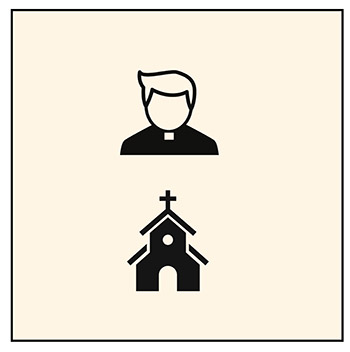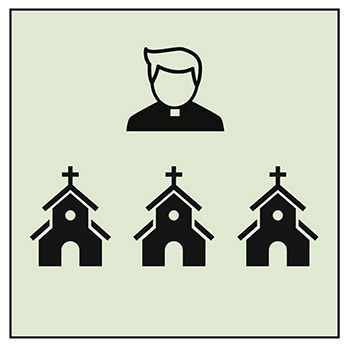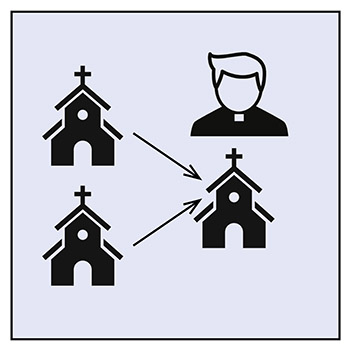
Editor's note: Scroll to the bottom of the page to see an explanation of what a pastorate is.
The Archdiocese of St. Louis has released a second set of draft models as part of the
All Things New strategic pastoral planning process.
The draft models, published online Feb. 8, have been refined to one for each of the 15 territorial planning areas. Planning area maps and the second round of draft models can be found at allthingsnew.archstl.org/Planning-Process/Second-Draft-Model.
Under the new draft models, each planning area has been divided into pastorates, areas for which a pastor would be responsible. Parishes will be reshaped from 178 individual parishes into 88 pastorates, with pastorates falling into one of three categories:
• A single pastorate with one pastor overseeing one parish (40-50 single-parish pastorates have been proposed). In this case, an individual parish may remain as its own pastorate, but it may have to adapt some of its ministries and Mass times due to priest availability and coordinate with other parishes, ensuring vibrant evangelization and social outreach initiatives.
• One pastorate with multiple parishes remaining as parish entities. In this case, two or more parishes remain financially independent of each other, but will share one pastor and pastoral team/staff.
• One pastorate with merged parish(es) becoming one entity. In this case, parishes would merge their resources and become a new parish (or parishes) with one pastor. Some mergers could be announced on Pentecost, May 28, with others decided later. Once it’s been discerned which parishes will come together as a pastorate, there will be a case-by-case examination of which parishes might be merged.
The All Things New planning committee analyzed proposed pastorates to ensure that each has the resources to sustain a new territory and model.
“From the very beginning of All Things New, we have been asking the question: ‘Which communities does it make most sense to have come together in light of demographic shifts, evangelization and social outreach efforts, resources and priest availability?’” said Father Chris Martin, vicar for strategic planning.
This will be the final set of draft models to be distributed, and the last opportunity for feedback before all information is shared with Archbishop Mitchell T. Rozanski, who will announce a final decision on Pentecost, May 28.
Pastors and key parish leaders will have an opportunity to provide their feedback on the second draft models through a survey from the Archdiocese by Feb. 17. Parishioners are encouraged to look at the new draft models and provide feedback to their pastor or key parish leaders.
Pastorate model
Pastorates will seek to balance the equitable distribution of priests across the archdiocese (it is projected that there will be about 130 to 135 priests available for full-time ministry about 15 years from now, archdiocesan officials said) with the resources and long-term viability of parishes, Father Martin said.
“Some parishes might be blessed with an abundance of resources, but it doesn’t mean that we have enough priests to oversee them,” he said. “If a priest is appointed as pastor of a multi-parish pastorate, one of the first conversations he would have is about setting new expectations for what ministry looks like.”
Father Martin noted the collaborative efforts that already exist in places across the archdiocese, including retreats, RCIA programs, and activities among Catholic schools and Parish Schools of Religion.
Considering feedback
Since the beginning of the All Things New process on Jan 25, 2022, the archdiocese has heard from more than 70,000 people through the Disciple Maker Index survey; hosted nearly 350 listening sessions at 178 parishes; surveyed 18,000 parish school parents, administrators, teachers, staff and more; compiled sacramental, financial and demographic statistics for every parish and school; met with community, civic and business organizations; held focus groups; and had conversations at the deanery and parish levels.
All of this is geared toward the archbishop making a well-informed, discerned decision for the spiritual well-being of the archdiocese, looking at the feedback of the people and the needs of the archdiocese, said Father Martin.
All Things New has been “the most thorough, far-reaching process for input, bringing in as many people on board as possible,” Archbishop Rozanski said. “All of us will be affected by this, but hopefully affected in a way that we see what we need to be as Church in reaching out and sharing the Gospel. That’s the heart of it — an awareness of reaching out, of evangelization, of spreading the Good News and living the Good News.”
>>Explanation of a pastorate
A pastorate is a parish or number of parishes overseen by a pastor. Depending on the situation, there may or may not be associate pastors at a given pastorate.
As part of All Things New, there will be three primary structures of pastorates:
• One pastorate with one parish
• One pastorate with multiple parishes remaining as parish entitites
• One pastorate with merged parish(es) becoming one entity
 One pastorate with one parish
One pastorate with one parish- One pastor oversees a parish, potentially with associate pastors
- Pastor is canonically the pastor of that parish
- Potential new Mass times or regional ministries
- Shared vision articulated by the pastor
- Mass celebrated regularly in one church
- One parish staff and outreach ministries
- One pastoral council
- One finance council
 One pastorate with multiple parishes
One pastorate with multiple parishes- Comprised of multiple parishes sharing the same priest as pastor, potentially with associate pastors
- Pastor is canonically the pastor of each parish in the pastorate
- Shared vision articulated by the pastor
- Mass celebrated regularly in multiple churches
- Parish staff shared between multiple parishes
- One parish council
- Each parish retains financial council
- Parish finances are not combined
 One pastorate with parishes merged into one
One pastorate with parishes merged into one- One pastor oversees the parish created by the merger of parishes, potentially with associate pastors
- Pastor is canonically the pastor of the merged parish
- Shared vision articulated by the pastor
- The churches in which Mass will be celebrated regularly will be determined locally
- One parish staff and outreach ministries
- One parish council
- One finance council
- Parish finances of the merged parishes are combined
>> Just cause
According to canon law, merging or suppressing a parish requires “just cause.” A just cause is required because the situation involves competing goods. On the one hand are the responsibilities of the archbishop toward the faithful and toward his priests, and his obligation to order the diocese prudently. On the other hand are the benefits the faithful receive from parish stability.
Many factors are considered when determining whether just cause exists. For example, one must consider whether the parish, in its current form, can fulfill its purpose. The purpose of the parish is not only to provide Mass, but also catechesis (with an emphasis on youth and young adults), works of charity, outreach and social justice, care for the sick, poor and isolated, support for spouses and families, promotion of communal and private prayer, and formation and support for the laity in their role in evangelization and mission.
The diocesan bishop alone has the authority to establish, suppress or alter parishes. He is required to consult the council of priests, and in addition to just cause, the reasons for modifying a parish must be “ad rem,” or relevant to that individual parish.